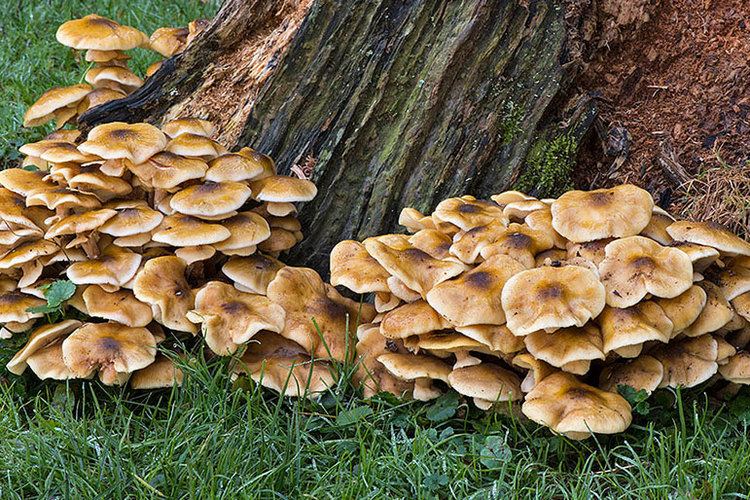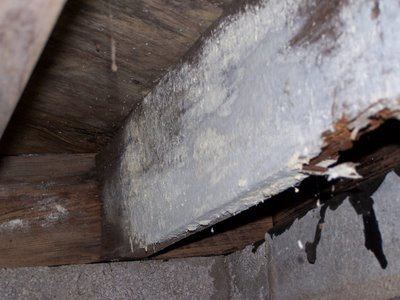 | ||
Representative species Turkey tail, Oyster Mushroom, Serpula lacrymans, Shiitake, Fomes fomentarius | ||
A wood-decay fungus is any species of fungus that digests moist wood, causing it to rot. Some species of wood-decay fungi attack dead wood, such as brown rot, and some, such as Armillaria (honey fungus), are parasitic and colonize living trees. Fungi that not only grow on wood but actually cause it to decay, are called lignicolous fungi. Various lignicolous fungi consume wood in various ways; for example, some attack the carbohydrates in wood and some others decay lignin. The rate of decay of wooden materials in various climates can be estimated by empirical models.
Contents

Wood-decay fungi can be classified according to the type of decay that they cause. The best-known types are brown rot, soft rot, and white rot. Each produce different enzymes, can degrade different plant materials, and can colonise different environmental niches. The residual products of decomposition from fungal action have variable pH, solubility and redox potentials. Over time this residue will become incorporated in the soil and sediment, so can have a noticeable effect on the environment of that area.

Brown rot

Brown-rot fungi break down hemicellulose and cellulose. Cellulose is broken down by hydrogen peroxide (H2O2) that is produced during the breakdown of hemicellulose. Because hydrogen peroxide is a small molecule, it can diffuse rapidly through the wood, leading to a decay that is not confined to the direct surroundings of the fungal hyphae. As a result of this type of decay, the wood shrinks, shows a brown discoloration, and cracks into roughly cubical pieces; hence the name brown rot or cubical brown rot. The fungi of certain types removes cellulose compounds from wood and hence the wood becomes brown colour.
Brown rot in a dry, crumbly condition is sometimes incorrectly referred to as dry rot in general. The term brown rot replaced the general use of the term dry rot, as wood must be damp to decay, although it may become dry later. Dry rot is a generic name for certain species of brown-rot fungus.
Brown-rot fungi of particular economic importance include Serpula lacrymans (true dry rot), Fibroporia vaillantii (mine fungus), and Coniophora puteana (cellar fungus), which may attack timber in buildings. Other brown-rot fungi include the sulfur shelf, Phaeolus schweinitzii, and Fomitopsis pinicola.
Brown-rot fungal decay is characterised by extensive demethylation of lignins whereas white-rot tends to produce low yields of molecules with demethylated functional groups.
Soft rot
Soft-rot fungi secrete cellulase from their hyphae, an enzyme that breaks down cellulose in the wood. This leads to the formation of microscopic cavities inside the wood, and sometimes to a discoloration and cracking pattern similar to brown rot. Soft-rot fungi need fixed nitrogen in order to synthesize enzymes, which they obtain either from the wood or from the environment. Examples of soft-rot-causing fungi are Chaetomium, Ceratocystis, and Kretzschmaria deusta.
Soft-rot fungi are able to colonise conditions that are too hot, cold or wet for brown or white-rot to inhabit. They can also decompose woods with high levels of compounds that are resistant to biological attack. Bark in woody plants contains a high concentration of tannin, which is difficult for fungi to decompose, and suberin which may act as a microbial barrier. The bark acts as form of protection for the more vulnerable interior of the plant. Soft-rot fungi do not tend to be able to decompose matter as effectively as white-rot fungi: they are less aggressive decomposers.
White rot
White rots break down lignin and cellulose and commonly cause rotted wood to feel moist, soft, spongy, or stringy and appear white or yellow.
White-rot fungi break down the lignin in wood, leaving the lighter-colored cellulose behind; some of them break down both lignin and cellulose. Because white-rot fungi are able to produce enzymes, such as laccase, needed to break down lignin and other complex organic molecules, they have been investigated for use in mycoremediation applications.
There are many different enzymes that are involved in the decay of wood by white-rot fungi, some of which directly oxidize lignin. The relative abundance of phenylpropane alkyl side chains of lignin characteristically decreases when decayed by white-rot fungi. It has been reported that the oyster mushroom (Pleurotus ostreatus) preferentially decays lignin instead of polysaccharides. This is different from some other white-rot fungi, e.g., Phanerochaete chrysosporium, which shows no selectivity to lignocellulose.
Honey mushroom (Armillaria spp.) is a white-rot fungus notorious for attacking living trees. Pleurotus ostreatus and other oyster mushrooms are commonly cultivated white-rot fungi, but P. ostreatus is not parasitic and will not grow on a living tree, unless it is already dying from other causes. Other white-rot fungi include the turkey tail, artist's conch, and tinder fungus.
White-rot fungi are grown all over the world as a source of food – for example the shiitake mushroom, which in 2003 comprised approximately 25% of total mushroom production.
